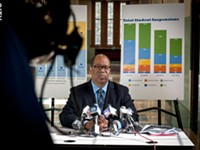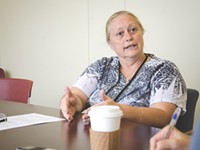[
{
"name": "500x250 Ad",
"insertPoint": "5",
"component": "15667920",
"parentWrapperClass": "",
"requiredCountToDisplay": "1"
}
]
Years of neglect at School 16 — classrooms regularly overheated, parts of the building smelled like urine — have lead Rochester schools Superintendent Bolgen Vargas to commission a report on the structural state of all the district's schools.
The report, which is due out next month, is supposed to help officials prevent a repeat of the School 16 situation, where repairs were ignored until it became a crisis and the school abruptly closed.
But the report will also likely ignite tense discussion between Vargas and members of the school board on several related issues: which schools to close, which to include in the second phase of the district's massive renovation project, and whether to scrap the district's school choice program in favor of neighborhood schools.
Vargas is looking for a new master plan because decisions about schools can't be made in isolation, says school board member Willa Powell.
Former Superintendent Jean-Claude Brizard changed the direction of the original renovation program, turning many of the schools in the first phase of construction into K to 8 schools. But the transition hasn't gone smoothly. It has created practical problems, and encountered resistance from some parents and neighborhood residents.
Parents tend to be attracted to smaller schools, and many want the district to go back to neighborhood K to 6 elementary schools. Another problem: the reshuffling has left some high schools with unused space, Powell says.
And if Vargas recommends closing schools, district officials would need to make sure they don't leave some neighborhoods with too many schools, and others without enough.
School board member Van White says the report should also lead to a full review of the school choice program. Even though parents are supposed to choose a school within designated zones, they are increasingly choosing schools outside those zones, according to district data. (District officials do not enforce the school choice program.)
And parents are basing their selection on more than the quality of the school, White says. They are picking schools that will allow their children to be bused rather than walk to school through unsafe neighborhoods.
"Parents are voting with the bus system," White says. "We're seeing black and brown flight away from these schools. What we need to do is strengthen them rather than encourage parents to keep abandoning them."
Allowing parents to choose outside their zone has turned other schools into catch-alls for the lowest performing students, White says.
Some of the funds needed to turn around failing schools might be obtained through more equitable funding among the schools, he says. But equitable funding was extremely controversial when Brizard attempted it.
"It's a little bit different," White says. "We're not talking about redistributing resources. At the very least, a comparative study [of the schools] would be a good launching pad for an important conversation we need to have."
And there's also the increasing cost of transportation. When students are bused across town, the district has to spend more money on transportation instead of the classroom.
But returning to neighborhood schools, a subject that re-surfaces almost every school year, comes with its own set of problems. Some parents will still vehemently reject a low-performing school despite its location.
Speaking of...
Latest in News
More by Tim Louis Macaluso
-

RCSD financial crisis builds
Sep 23, 2019 -

RCSD facing spending concerns
Sep 20, 2019 -

Education forum tomorrow night for downtown residents
Sep 17, 2019 - More »








